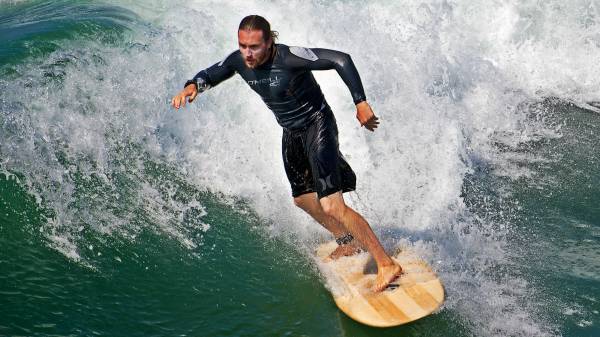Low back pain and problems exist in a variety of forms, and diagnosis is critical to knowing what the best exercise is to create the best outcome. After diagnosis, there is still a skill in knowing what to prescribe and why to prescribe it.
After establishing that there is no “best” universal exercise to prescribe for a lower back problem in my last article, I’ve received a lot of questions about kettlebell swings and their use in low back rehab. This article will examine the swing in detail, and why I find it highly effective in rehabilitating the lower back – but only for the right athlete, and at the right time.
When prescribed correctly, kettlebell swings can be instrumental in later stage low back rehabilitation.
Force Application for Rehabilitation
Lifting weights comes at a cost on the lumbar spine that can be understood in terms of spinal compression, when the force is produced down the spine, and shear, when the force is applied across it. One of the most important factors in later stage low back rehabilitation is building lumbar spine musculature endurance. The aim is to create lumbar spine neutral control endurance while increasing these compression and shear force loads.
The ideal kettlebell swing here creates a hip-hinge deadlift style pattern, with an unnegotiable vertical tibia decreasing the joint movement at the ankle and knee. I don’t want a squat-style-swing where the knee and ankle movement will decrease spinal sheer and compression forces. The patient will be tolerant to those at this point, so it becomes about building strength endurance.
A Step-By-Step Implementation
Knowing if the patient would benefit from a kettlebell swing prescription takes a strong understanding of their goals and sport requirements. Swings can be programmed for most people, but is not the choice of exercise to use in an acute disc injury, for example, as pain fundamentally alters movement. The kettlebell swing should be used only when pain has been abolished and the rehabilitation path is aimed at restoring athletic performance. If you have read my previous articles, you will already know that I don’t consider an athlete restored to function unless they can flex their lumbar spine painlessly, and under a load that relates to tasks their sports require.

I’ve treated a few surfers over the years. In all cases, swing work was the moment their progress leaped forwards.
The first step is confirming the patient can tolerate spinal compression without pain, then applying manual shear force to the spine to ensure that the shear forces are also painless. At this stage of rehabilitation, I’m focussing on neutral spine control and optimisation. The patient must pass these tests to move on to the swing. This is not negotiable.
When rehabilitation commences, I begin with a deadlift-based technique. This is in line with clear research evidence that hip dominant flexion patterns are safer than lumbar dominant ones. I teach the hip hinge as a preferred movement pattern. If necessary, I will have done significant work to produce an excellent hip hinge by this point with a variety of hip hinge patterning and neutral spine hip hinged deadlifting.
I start with kettlebell deadlifting before barbell deadlifting, as this brings the mass closer to the patient’s centre of gravity. This would begin in sumo stance before proceeding to conventional form. To progress to the swing, it is critical that the patient demonstrates excellent deadlift technique beforehand.
The Surfer and the Swing
Here’s an insight into clinical application. I’ll use a case study of an international surfing athlete who came to me with a multitude of lumbar spine issues dating back many years, including two major disc bulges with neural involvement. Over a period of six months, I had reached the point of implementing kettlebell swings into his rehabilitation. Although progress was slow, it had been constantly progressive and he was able to surf during this time, with limitations as high as pain levels allowed.
“The kettlebell swing is the safest exercise for low back pain, but only when the patient has progressed through all the other best exercises beforehand.”
The start of the swing work was the moment that his progress leaped forwards. Initially, I prescribed sets of 3-5 reps. I looked for perfect form, as I always do, and only increased repetitions when that was clearly demonstrated. Within two months, he was performing 3 sets of 60 reps using a 20kg kettlebell twice per week. Soon after, he was enjoying two-hour surfing sessions without pain for the first time in years. I have had a few surfers over the years, and the hip-hinge-deadlift-patterned-swings I have detailed here all led to huge improvements in their tolerance to time spent in the water.
An Athlete-Focused Prescription
I treat people with different body masses and anthropometrics, and prescribe the swing with a specific focus to the athlete’s performance demands. That is what I teach across the board: knowing when the right exercise is to be applied, and getting athletes back to the top quickly and safely, using objective markers. Keeping this in mind, the kettlebell swing is the safest exercise for low back pain, but only when the patient has progressed through all the other best exercises for low back pain and has regained excellent neutral spine control and hip hinge patterning. After this level of rehab, much more can and should follow.
To understand the swing in rehab requires an understanding of the science of low back injuries. I’ll be teaching on this with weekend courses throughout 2016 both in Australia and the US. The first one is a 2-day event in March that I’ll co-present in Melbourne with Andrew Read and Greg Dea. Click here to book your tickets.
Photo 1 courtesy of Rich Manaro.
Photo 2 courtesy of Shutterstock.






